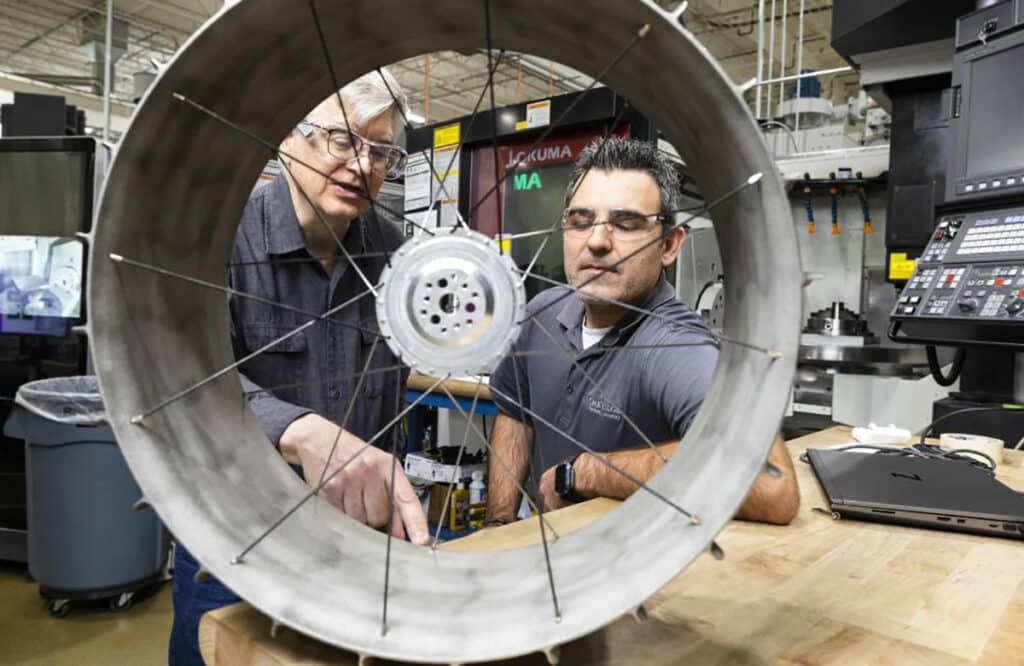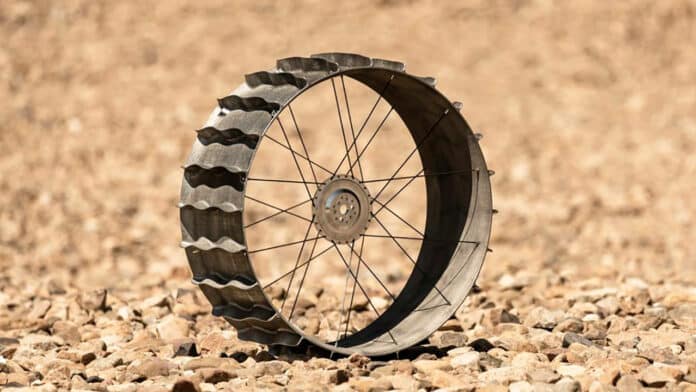When it comes to planning missions to the Moon, every gram of weight is crucial on launch day. Therefore, it makes sense to use available resources when you land. For instance, imagine a rover that can fly to the Moon without any wheels and instead 3D print them on-site using lunar soil, or regolith, as a raw material once you land. This could be a game-changer for future lunar missions.
Researchers at the Department of Energy’s Oak Ridge National Laboratory (ORNL) have teamed up with NASA to bring additive manufacturing to space exploration. Researchers 3D printed the same kind of wheel that the space agency uses for its upcoming robotic lunar rover.
The additively manufactured wheel was modeled on the existing, lightweight wheels of the Volatiles Investigating Polar Exploration Rover (VIPER). VIPER is a mobile robot that NASA plans to send in 2024 to map ice and other potential resources at the south pole of the Moon. This mission is intended to help determine the origin and distribution of the moon’s water and whether enough could be harvested from the moon’s surface to support people living there.
While the prototype rover wheel will not actually be used on the NASA Moon mission, it was created to meet the same design specifications as the wheels made for NASA’s rover. Additional testing is planned to validate the design and fabrication process before using the technology for future lunar or Mars rovers and other space applications like large structural components.
The use of additive manufacturing can reduce energy consumption, minimize material wastage, and reduce lead time while allowing for design complexity and material property customization.
ORNL’s Manufacturing Demonstration Facility (MDF) researchers used a specialized 3D printer to print the rover wheel prototype at ORNL, which utilized two coordinated lasers and a rotating build plate to selectively melt metal powder into the designated shape. A typical metal powder bed system rakes a layer of powder over a stationary plate. Then, a laser selectively melts a layer before the plate lowers slightly, and the process repeats.
According to Peter Wang, who leads MDF development of new laser powder bed fusion systems, the printer used for the rover wheel prototype is large enough for a person to enter and is unique in its ability to print large objects while the steps occur simultaneously and continuously.

“This dramatically increases the production rate with the same amount of laser power,” he said, adding that deposition occurs 50% faster. “We’re only scratching the surface of what the system can do. I really think this is going to be the future of laser powder bed printing, especially at large scale and in mass production.”
Researchers used software developed at ORNL to “slice” the wheel design into vertical layers, then balance the workload between the two lasers to print evenly, achieving a high production rate leveraging a computational technique recently submitted for patent protection.
Made of a nickel-based alloy, the prototype wheel is about 8 inches wide and 20 inches in diameter – much larger than typical parts printed with metal powder bed systems. Making it required the ability to print small geometric features spread over a large work area. The team says additive manufacturing enabled greater complexity in the rim design without added cost or manufacturing difficulty.
In comparison, the four VIPER wheels that will churn through moon dust next year required multiple manufacturing processes and assembly steps. VIPER’s 50-piece wheel rim is held together with 360 riveted joints. The manufacturing process required complicated and time-intensive machining in order to meet the mission’s rigorous requirements.
If NASA testing proves the 3D-printed prototype to be as robust as conventionally built wheels, future rovers could use a single printed wheel rim instead, which took ORNL 40 hours to manufacture.
ORNL and NASA engineers also explored printing precise design features, such as angled sidewalls, a domed shape, and a wavy tread to increase the wheel’s stiffness. Integrating such features into the VIPER wheel design using conventional manufacturing processes is challenging. However, 3D printing made it simpler and more cost-effective to design and assemble a more complex spoke pattern and spoke locking mechanism for the wheel.
“The project with NASA really propelled the technology forward,” said Brian Gibson, the researcher who led the rover wheel project for ORNL, calling it a milestone. “It was great to connect a capability with a developing need, and the team was excited to be making a prototype component with space exploration applications.”
